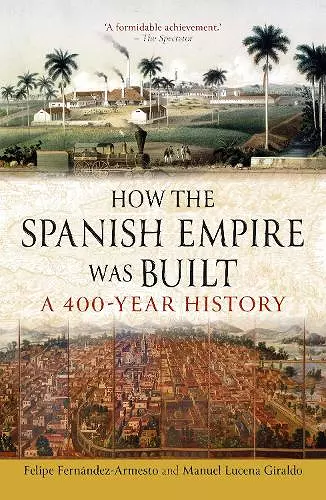How the Spanish Empire Was Built
A 400-Year History
Felipe Fernández-Armesto author Manuel Lucena Giraldo author
Format:Paperback
Publisher:Reaktion Books
Published:1st Nov '25
Should be back in stock very soon

In the sixteenth century, Spain was small and divided, yet it built the largest empire in history. How? Felipe Fernández-Armesto and Manuel Lucena Giraldo reveal the crucial role of engineers in this achievement. By investing in infrastructure that benefited local elites, Spain expanded its influence and enriched trade networks. Through vivid stories of engineers, prospectors, soldiers and priests, the authors bring Spanish America’s age of conquest to life. Now in paperback, this dazzling history redefines empire as a venture shaped by collaboration as well as oppression, offering fresh insights into the rise of the Spanish Empire and the complexities of its legacy.
An essential book, magisterially written . . . in a limpid, clear style, without sacrificing academic rigour. * Fernando R. Lafuente, ABC, Spain *
[The authors] explore an under-appreciated yet essential dimension of the Spanish Empire: the public works which allowed . . . a small European minority to control, develop and defend a vast territory. * Alfonso López, National Geographic España *
The authors demonstrate a rare capacity to make accessible a voluminous knowledge of the reality of the overseas territories of the Spanish Monarchy . . . [this book] should be in the library of every lover of American history. * Maria Saavedra, El Debate *
"What have the Spaniards ever done for us?" imperial subjects may have asked, plotting rebellion. "Aqueducts?" One may have ventured. "Okay, aqueducts. What else?" "Appeals courts?" "Right! Appeals courts. And?" "Well, the mails?" "Okay. So there are the aqueducts, the appeals courts, the royal mail. But really, what have the Spaniards ever done for us?" "Hospitals?" "The transoceanic fleet system?" "Defensive fortifications?" "Arched bridges?" "A standardized writing system?" One gets the idea. Certain to spark heated discussions like this one, How the Spanish Empire was Built offers a comprehensive defense of Spanish logistical ingenuity, a neo-Roman project of truly global dimensions. Known mostly to Spanish historians of science and engineering until now, the logistical stuff of empire, what made it function day-by-day for so long despite the tyranny of distance, the temptations of corruption, and the relentless downward tug of entropy, has remained obscure to most Anglophone readers. In an age obsessed with global supply chains, instant communications, and global epidemics, there is much to be learned from predecessors who first encircled the world, for better or worse. The authors say this is simply a book about the "scaffolding of empire," but it is about much more. It is a provocation. * Kris Lane, Tulane University *
Be prepared: Fernández-Armesto and Lucena Giraldo will sweep you off the solid ground of what you thought you knew about empire, as they dive beneath the scholarly wave of structuralism to find an infrastructural undertow. But fear not. In the hands of these historical engineers, as witty as they are erudite, this manual for how to make an empire offers an answer to an old question: how on earth did imperialists do it? And their answer is as well designed, built, and fortified as Spain’s colonial enterprise mostly seems to have been. * Matthew Restall, author of Seven Myths of the Spanish Conquest and When Montezuma Met Cortés *
How the Spanish Empire was Built is extraordinarily learned, and gilded with linguistic flourishes. * Literary Review *
A formidable achievement * David Crane, The Spectator *
'The world’s most successful empires have been engineers’ creations.’ This assertion, made by Fernández-Armesto and Lucena Giraldo in How the Spanish Empire Was Built: A 400-Year History, seems bold at first, almost audacious. Yet within the span of the book’s first two chapters, the authors’ contention seems not only logical and wise but almost irrefutable. . . . A richly researched account of the clever, industrious and deeply practical men who followed in the footsteps, often literally, of Columbus, Cortés, Pizarro, Núñez de Balboa and others. The mission of these takers of territory was completed, the authors argue, by the engineers—makers of ‘the scaffolding . . . on which empire was erected.’ * Wall Street Journal *
ISBN: 9781836391135
Dimensions: unknown
Weight: unknown
352 pages